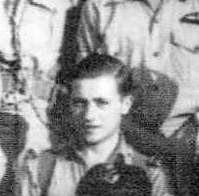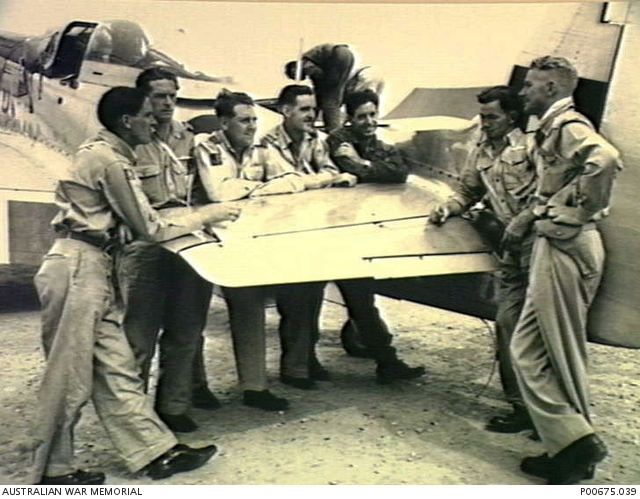FLTLT Kenneth Duncan McLeod 031479
DFC



| Squadron/s | 457 SQN 77 SQN |
| Rank On Discharge/Death | Flight Lieutenant (FLTLT) |
| Nickname | Ken |
| Mustering / Specialisation | Pilot |
| Date of Birth | 14 Apr 1920 |
| Date of Enlistment | 02 Jul 1940 |
| Contributing Author/s | Edited David Hamilton. Citation Jack Langley. Updated by Vince Conant July 2013 The Spitfire Association |
Ken was born on the 14/4/1920 in Sydney, NSW. He enlisted on the 2/7/1940 and after training as a pilot qualified for fighters. He served with No 457 Squadron (Spitfires) and remained in the RAAF after WW2 and served in Korea where he won the DFC.
Although the combined UN forces' airpower was superior to North Korea's, the entry of the Chinese into the war made the situation in the air more complicated. They too had airpower, and to the dismay of the UN forces, superior aircraft - MiG-15 jet fighters. In response, 77 Squadron had to switch from flying Mustangs to Meteor jets.
Chinese ground forces were more skilled than the North Korean forces in avoiding the damage caused by UN airpower. They were more mobile, better camouflaged, better able to cross large distances quickly, and were less reliant on supply networks, scrounging for food and other supplies as they travelled.
The death of 77 Squadron's commanding officer, Wing Commander Lou Spence, just over two months into the war on 9 September 1950, sent a shock through the squadron. His aircraft crashed during a ground attack over Angang-ni. Spence was replaced by Wing Commander Dick Cresswell.
On 1 December 1951, fourteen Meteor jets of 77 Squadron were attacked by some fifty MiG-15s high over North Korea. At least one MiG was shot down, the first victory by a Meteor, but three Australian pilots were downed. One of the three was Sergeant Vance Drummond, who landed in enemy territory south-east of Pyongyang and was taken prisoner (POW).
In 1952, UN strategy shifted to "air pressure" - an attempt to force the Chinese into battle and defeat them. The improvement of the Chinese and North Korean anti-aircraft weapons increased the danger of this campaign. In the final stages of the war, the strategy of air pressure concentrated on the destruction of ground targets - an area where UN airpower continued to be successful.
At times the weather was just as hazardous to pilots as flying under attack. Taking off was difficult in winter: thick ice and snow had to be removed each morning from the aircraft. In the event of ditching in the sea, pilots' immersion suits gave them only a few minutes to be rescued before the freezing water temperature would kill them. The heat of summer created problems as well: sometimes bitumen would melt onto the underside of aircraft during take-off and landing. The humid summer haze extended into the atmosphere up to 1,000 metres, cutting visibility to less than three kilometres.
The pilots of 77 Squadron flew almost 19,000 individual sorties while in Korea. Their performance also reaped diplomatic rewards: their excellent reputation played a large role in the signing of the ANZUS pact. Yet despite their successes, during three years of operations 77 Squadron paid a high price. Forty pilots were killed - 30 killed in action, eight in accidents, and two in accidents on the ground. Six were captured and became POWs. Of the squadron's 90 Meteors, 54 were lost during the war.
Flying Officer K.D. McLeod has led flights of No 77 squadron against North Korean forces and shown outstanding devotion to duty and courage. His personal efforts to press home attacks to greatest advantage and his skilful leadership in obtaining the maximum effort from those sorties led by him have resulted in highly satisfactory results in the number of armoured vehicles and transports destroyed by his flights. [LG 17/4/1951 p 5173]
He was discharged 24/11/1954 from the School of Law, Williamstown.

